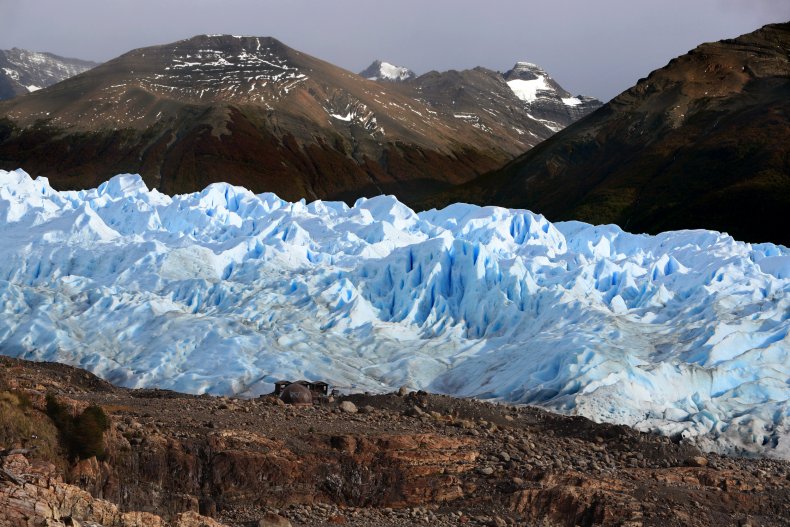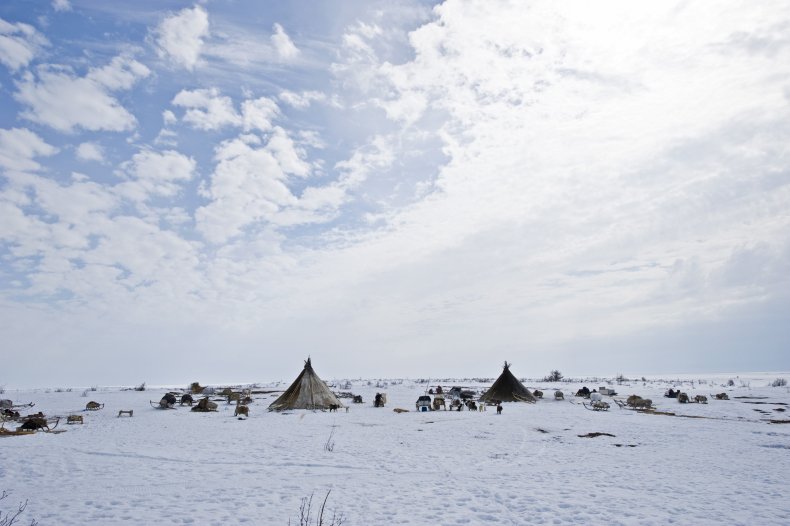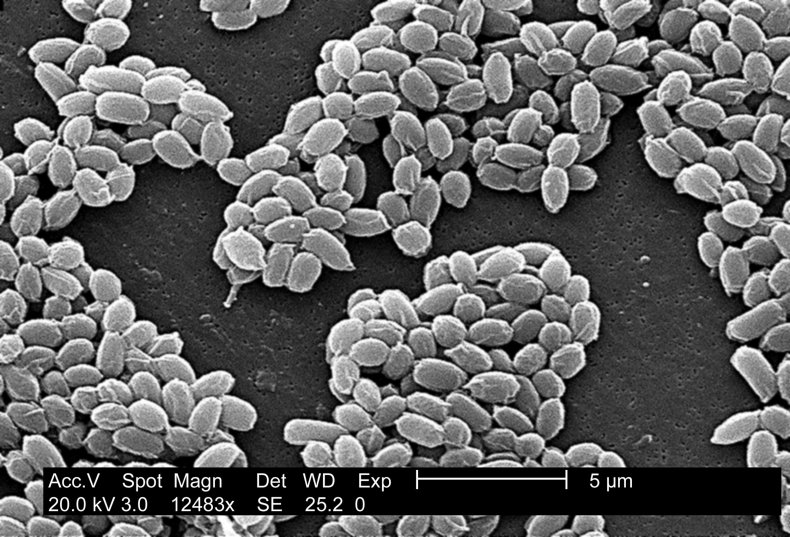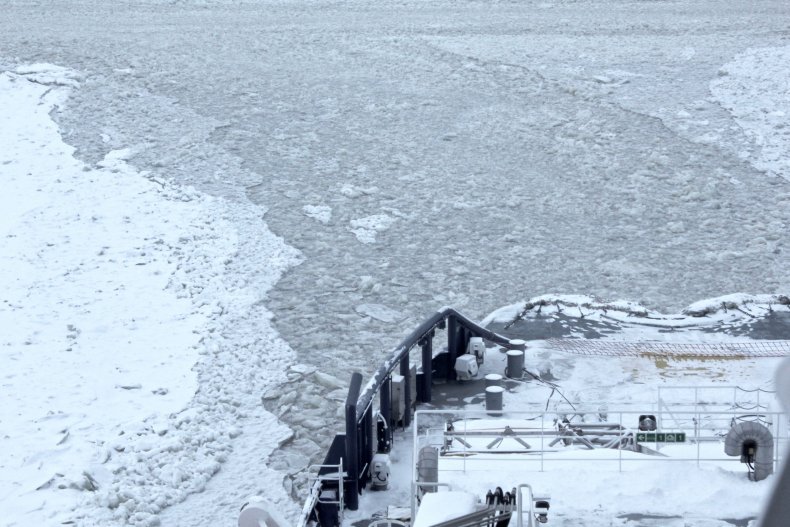Can Melting Ice Release Viruses That Are Harmful to Humans
As the planet warms and the ice thaws, scientists warn we could see the re-emergence of ancient pathogens currently unknown to science. These viruses, which have laid dormant and locked away in glaciers and permafrost—permanently frozen soil—for hundreds if not thousands of years, could "wake up," researchers accept said.
Earlier this year, scientists analyzing two water ice core samples from Guliya water ice cap, Tibet, identified several of such viruses. Ane of the core samples dated back 520 years, while the other held sediments locked away fifteen,000 years ago. Four of the virus genera—the taxonomic rank between species and family—were already known, but 28 had never been seen before.
The written report authors say the research provides evidence of an "ultra-make clean" method of microbial and viral sampling—one make clean enough to extract virus from the glacier unharmed and uncontaminated
Still it also reveals a affiliate in the planet's biological history, exposing some of the microbes that inhabited the soil hundreds and thousands of years ago that could, theoretically, re-emerge as the ice melts.
The written report'southward authors warn that water ice cook "will release glacial microbes and viruses that have been trapped and preserved for tens to hundreds of thousands of years."
This cook could destroy microbial "archives" that may help us empathise the World'south climate regimes in the past. "Nevertheless, in a worst-case scenario, this ice cook could release pathogens into the environment," they add together.
Their enquiry is in the preprint stage, meaning it has not been reviewed past a panel of experts to confirm the findings. As such the results should be viewed with caution. It is also not clear how complete or infectious these viruses would be post-thaw. However, scientists have previously revived viruses that take been fallow for thousands of years, suggesting it is at least a possibility.
Could ancient viruses pose a public health risk? "Possibly," Jean-Michel Claverie, Professor of Genomics and Bioinformatics at Aix-Marseille University in France, who was not involved in the Tibetan glacier study, told Newsweek.
"They could be ancient viruses that we already know—such every bit smallpox virus—that we wrongly think were eradicated," he added.
"In that location also could be viruses that caused creature—or human being—extinctions in the past, and that modernistic medicine is not aware of. The same is true of pathogenic bacteria, such as those causing anthrax."

Claverie's research has shown that viruses can "survive" tens of thousands of years—"since the Neanderthal era"—unperturbed, provided the conditions are right. In 2014, he co-authored a paper describing a xxx,000-year-sometime "giant virus" extracted from Siberian permafrost. Out of the permafrost and in the lab, information technology revived, becoming infectious after a millenia spent dormant.
Giant viruses like these go their name because they are and so large, relatively-speaking, they can be hands viewed under a low-cal microscope. While an boilerplate virus can exist as small-scale as 20 nanometers, a giant virus cannot fit through a hole 200 nanometers or smaller.
The one discovered in 2022 has been named Pithovirus sibericum; "pithos" beingness the name of a large storage container used by the Aboriginal Greeks. Since then, the squad has discovered at least one other ancient virus, Mollivirus sibericum, found in the aforementioned 30,000-yr-old ice sample.
Fortunately, both assail amoebas—single-celled organisms with the power to shape-shift—and non animals or humans. This means its resurrection did not pose a public health take a chance. However, researchers say their existence raises the question of what other, more deadly pathogens peradventure waiting in the permafrost, ready to activate.
The virus' impressive longevity stems from the fact that technically, they are not living things. To activate and reproduce, they must penetrate the cell of a living organism. Exterior of a cell, they are metabolically inert particles called virions, which can be imagined every bit seeds to the activated virus, said Claverie.
This means they cannot die in the typical sense. Virions can either be infectious and ready to "germinate" or inactivated, too damaged to infect or germinate.
This deterioration process can take identify rapidly exterior of a cell—light, for example, is incredibly damaging to the virus Dna or RNA. The loss of moisture can also cause impairment to the point of inactivation.
However, if the conditions are conducive to their "survival," they tin can remain infectious for extended periods of time.
"UV calorie-free, oxygen, high temperature is bad, common cold and darkness is better, cold, darkness and no oxygen [anoxic] is best," said Claverie. That makes permafrost and deep sea sediments —common cold, dark, anoxic—splendid environments for microbes similar viruses.

The increased interest in ancient viruses and water ice-locked microbes has not only been spurred past Claverie and others' research, but by scientific data highlighting a rapid increment in ocean warming and ice cook.
Nosotros know the Chill is warming twice equally fast as the rest of the earth, while ice sheets across the planet take shown consequent thinning linked to climatic change and changing weather patterns.
The last 2 months have seen Antarctica suspension its record for ice melt—it was reported that xv per centum of the continent's surface melted on Christmas Eve—and record warm water nether its most precarious glacier, the Thwaites glacier.
Smaller glaciers are also feeling the heat. Last yr's Intergovernmental Panel on Climate Modify (IPCC) report found that glaciers in Europe, eastern Africa and elsewhere could lose more than than eighty percent of ice mass by the cease of the century. Meanwhile, permafrost in the Arctic circle is thawing at a rapid pace.
Permafrost covers 24 percentage of the Northern Hemisphere, an area equivalent to ix million square miles, according to Columbia'due south Earth Institute. Scientists predict that even if we were to limit warming to 2 degrees Celsius above pre-industrial levels, we would eventually lose 40 percentage of that.
As the permafrost thaws, these snow-covered landscapes are turning from carbon sinks into carbon emitters with the potential to release vast amounts of greenhouse gas and cause the infrastructure it supports to crumble.
This warming could likewise unlock viruses currently subconscious in the ice and permafrost. Although the likelihood of these ancient or historic viruses reactivating remains relatively unknown.
"This is a new surface area of inquiry," Christine Kreuder Johnson, Professor of Epidemiology at University of California Davis, School of Veterinary Medicine told Newsweek. "I would say very heady. [There is] not a lot known."
One of the key things to consider when investigating ancient viruses like those plant in the Tibetan glacier, Kreuder Johnson explained, is the state of the virus—is it whole or is it fragmented? Considering this will affect its ability to infect and therefore, the threat information technology poses to human wellness.
"Viruses detected only pose a run a risk if they're completely whole and can regrow," said Kreuder Johnson.
Some microbes are hardier and, therefore, more probable to exist infectious than others. Take, for example, spore-generating bacteria like anthrax.
Anthrax is not technically an ancient disease—it can be found in soil across the world—but it has been called a "zombie pathogen." This is because it can prevarication latent for centuries before reactivating and triggering new outbreaks.
In 2016, a 12-year-old boy died and dozens more were hospitalized in Salekhard, northeast Russia, with anthrax—dubbed the "Siberian plague." The outbreak is believed to accept originated from the diseased remains of humans and animals buried in permafrost 75 years earlier, later exposed after a oestrus moving ridge caused the ice to thaw.
It is thought that reindeers came into contact with the remains, spreading the disease to humans. The boy was one of a number of nomadic herders affected, Newsweek reported at the time.
Medical experts cited climate change equally a factor in the outbreak, pointing to the abnormally warm atmospheric condition that had acquired the permafrost to thaw. This is supported by studies that suggest rising temperatures could atomic number 82 to similar incidents in the future.

Elsewhere, in that location have been reports of researchers contracting diseases after coming into contact with the frozen carcasses of diseased animals.
Michael Zimmerman, a paleopathologist at the Academy of Pennsylvania, told NPR he adult seal finger—a bacterial infection that typically affects the fingers and hands of seal hunters—while completing enquiry on animals buried in the permafrost for decades. The diagnosis was not confirmed but matched the symptoms and responded to antibiotics, the drug prescribed to treat seal finger.
Stories of and then-chosen zombie diseases, or pathogens, like anthrax receive a lot of media attention—but bodily cases have, and then far, been rare. Many scientists would say fears over ancient or historic diseases are overblown, and point to the fact that we are exposed to viruses on a most-constant basis.
"Viruses are everywhere—in soils, in ice, on money," Professor Paul Falkowski, who leads the Environmental Biophysics and Molecular Ecology Laboratory at Rutgers University–New Brunswick, told Newsweek.
"Virtually all viruses accept no effect on human being health. However, some microbes, such every bit anthrax bacteria, tin emerge from frozen soils later on decades and infect people" He adds: "Just the take chances is very low."
When considering the possible health risk of ancient viruses, information technology is besides important to think about exposure. About infectious diseases are transmitted past direct contact, bodily fluids and respiratory droplets—"in other words, there is nigh no danger of long range manual," said Falkowski.
A virus found in an isolated region of Siberia or atop a Tibetan glacier might not be too risky because there is a low risk of exposure. In contrast, high concentrations of people in urban areas increases contact and exposure, which in plough increases the hazard of illness outbreaks.

That may change as humans and animals answer to rising temperatures. Thawing of ice in the poles may touch on how we navigate the planet, with new routes in the Arctic opening upward. A changing climate may also push species to expand their range to new parts of the globe. The current administration'south plans to expand land available for drilling in the Chill Circle, for example, could open up new paths to exposure.
Kreuder Johnson and her colleague Tracey Goldstein, Professor Pathology, Microbiology, Immunology at UC Davis told Newsweek these behavioral changes could lead to animals and microorganisms interacting in different ways or coming into contact with pathogens for the kickoff time.
For example, Goldstein'due south research into the phocine distemper virus (PDV), a potentially deadly infectious disease that targets seals and other marine mammals.
The study found lower levels of sea water ice in the Arctic circle were positively correlated with higher infection rates among certain seal species. The study'due south authors suggested changes in habitat and interactions betwixt species may have been behind the fasten.
Still, for now, the bulk of information we accept is sparse and hypothetical. The potential for new—or rather ancient—microbes to re-sally in a warming climate is a relatively new set of circumstances only starting to be researched.
"Information technology's but something we should keep on our radar," said Goldstein. "The climate is changing then speedily and we don't know what the next thing might exist that's going to be a concern."
Claverie agrees: "Warming plus more people in previously uninhabited chill regions are the recipe for disaster—in theory," he said. "However, nobody knows how to estimate the probability of this to happen. We merely know from our work with amoeba viruses that it is, in principle, a possibility."
Source: https://www.newsweek.com/melting-glaciers-thawing-permafrost-ancient-viruses-1486037
Postar um comentário for "Can Melting Ice Release Viruses That Are Harmful to Humans"